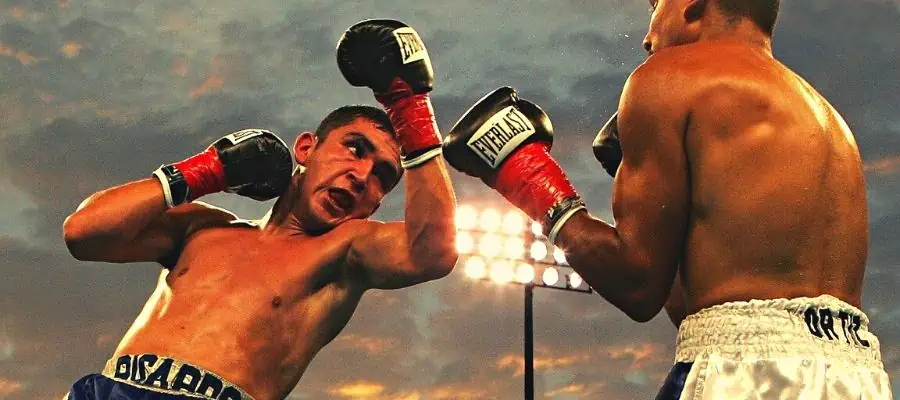There is no doubt that weight matters in boxing. It might be the most important factor when it comes to success in the ring, besides the skill of the boxer. But does weight matter to the extent that some people think it does? And why do different weight classes exist?
In general, weight matters a lot in boxing, but to a certain threshold. If we are talking about weight differences within the same weight class, then weight can play a lesser role. If we are talking about weight differences between two weight classes, then weight plays a major role.
But there is more to know about weight classes and weight differences than meets the eye.
Why Is Weight Important In Boxing?

Fighters often risk not fighting due to the risk of not passing the scale before the fight. Why do they do that? They do it because, in boxing, every ounce of weight advantage you have can play a role in your winning or losing. Boxers often go through serious and often dangerous weight-cut routines.
Weight cutting is standard practice in combat sports. It is thought to give the fighter an advantage since he is fighting in a weight class that is lower than his natural settling point. So as you can see, weight does play a major role when regarding two fighters within the same weight class.
Also, for those fighters who want to try themself in competitions, it may be good to know how boxers can cut their weight fast. For these, you can read our article that gives advice on how to do it.
However, the weight difference between two different weight classes can be of even greater importance. There is a reason why very few boxers try and fight out of their weight class. Not only boxers but also kickboxers and MMA fighters. The reason is due to the disadvantage they would be in if they fought a bigger opponent.
Bigger opponents can often pack a stronger punch. They can also use their size to keep you at bay. Their weight advantage allows them to bully you. They can often get into the clinch with you and rest their weight on you. This practice is standard in boxing. It can seriously tire you out since you are not only carrying your weight but also the weight of the larger opponent.
Weight Classes

The first recorded boxing match took place in England in 1681. The rules of that fight were simple: two men fought until one was knocked out or thrown in the towel. There were no weight classes. There were no weight divisions of any kind in boxing until the late 19th century. That all changed when the Marquess of Queensberry rules were introduced in 1867.
These new rules codified many aspects of the sport, including the introduction of weight classes. The rationale behind weight classes was simple. The goal was to create a more level playing field and make sure that fights were between competitors of similar size. After all, it wouldn’t be fair to pit a 130-pound man against a 250-pound, would it?
Weight classes have been a part of boxing ever since, and they play a major role in determining who fights whom. Today, there are 17 different weight classes in professional boxing. The weight classes range from flyweight (106 pounds) to heavyweight (200+ pounds).
The Evidence

But does weight matter in boxing? Let’s take a look at the evidence. There is no denying that size plays a role in boxing. The bigger fighter usually has an advantage in reach, power, and weight. That being said, there are plenty of examples of smaller fighters who have overcome these disadvantages to win fights against larger opponents.
Underdogs
One need only look at the history of boxing to see that weight is not always a determinant of success. Fighters like Sugar Ray Leonard, Roberto Duran, and Pernell Whitaker all won world championships despite being undersized for their respective divisions.
At the same time, there are many examples of bigger fighters who have struggled against smaller opponents. Wladimir Klitschko, for instance, had a lot of trouble with boxing’s “little men” throughout his career. However, he was and still is one of the greats.
Usyk vs. Joshua
The most recent example was the fight between Oleksandr Usyk and Anthony Joshua. Usyk, the smaller fighter, was considered the underdog going into the fight. He had never fought at heavyweight before, and Joshua is one of the biggest men in boxing.
But Usyk came prepared, used the advantages he had, and prepared for the advantages Joshua had. Usyk dominated Joshua over 12 rounds to become the undisputed heavyweight champion of the world.
In fact, Usyk, in our opinion, is an incredible fighter. He is a powerful boxer and one of the fastest heavyweights in the world. Also, be sure to check out our article on a few more of the fastest boxers of time.
Canelo vs. Khan
Another example where weight played a significant role was the fight between Canelo and Khan. Khan is naturally the smaller fighter, and he was at a disadvantage in reach and power. However, he used his speed and movement to great effect, winning several rounds against Canelo.
It was only in the later rounds that Canelo’s superior weight and power began to tell, and he eventually stopped Khan in the sixth round.
Height Also Plays A Major Role

Oftentimes, heavier fighters are also taller than their lighter counterparts. This gives the bigger fighters several advantages. In boxing, weight and height can play a significant role in both offense and defense. Taller fighters often have a longer reach.
A longer reach can give them an advantage in landing punches. A taller fighter’s longer arms may also make it more difficult for an opponent to land punches on him. A heavier fighter may have more power behind his punches. This can make it difficult for his opponent to absorb the impact.
Weight and height can also be factors in defense. A taller fighter may be able to use his reach to keep his opponent at bay. While a heavier fighter may be able to use his mass to smother his opponent’s attacks. Of course, these are just general trends – there are always exceptions to the rule.
Ultimately, it is up to each fighter to figure out how to use their weight and height to their advantage.
In Which Weight Classes Does Weight Matter Most?

So does weight still matter in boxing? There is no definite answer. In lower weight classes, where the fighters are more evenly matched in size, weight can be a deciding factor. Even a difference of a couple of pounds can give an upper hand to the heavier boxer.
But in the higher weight classes, where the weight of the fighters can vary greatly, it doesn’t matter all that much. Some people believe that being heavier gives an automatic advantage to a boxer because they will have more power. A heavier boxer will indeed pack more of a punch.
But they will also tire more quickly and may not have the same agility or speed as their lighter opponents. In the end, it depends on the individual boxer and how they use their weight to their advantage.
Smaller Fighters
The difference is that smaller fighters do not pack such a strong punch as their heavier counterparts. For that reason, we do not see as many knockouts as we do in heavyweight boxing. But don’t be fooled; even the smaller fighters could take your lights out quick if they needed to.
The smaller fighters focus more on speed and technique. They cannot put away a fighter with one punch as their heavyweight counterparts can. For this reason, we can see that the fights in the lower divisions are usually backed by better technique. The smaller fighters need to develop a killer skillset to be competitive.
In the end, skill and technique are usually more important than weight.
The Most Famous Weight Class
The most common weight class for boxers is heavyweight. Heavyweight boxing is a division of professional boxing in which fighters who weigh more than 210 pounds (15 stone or 95 kilograms) compete. The limit has varied over the years, but it was finally established at its current level in 1987 by the International Boxing Federation.
How Can I Outbox A Heavier Opponent?

Outboxing a heavier opponent can be quite difficult. But if you use your lower weight and better speed to your advantage, you can come out on top.
Use Your Weight To Your Advantage
If you are lighter than your opponent, you can use your weight to your advantage. You can use your speed and agility to stay out of their reach and land quick, less powerful punches. Chances are, you will not win by a knockout. So you have to have a game plan ready.
A game plan that will help you win through points. The more punches you throw, the more points you will score. Even if the punches aren’t causing much damage, you still need to overwhelm your opponent.
Stay Calm And Composed
It can be easy to get overwhelmed when fighting someone larger and stronger than you. However, it is important to stay calm and composed to make smart decisions and maintain control of the fight. If you stay relaxed and quick on your feet, you will have a better chance of winning.
Be Aggressive
To win the fight, you need to be the aggressor. You need to be the one throwing punches and dictating the pace of the fight. As I said earlier, throw a lot of punches. Combine punches to the head and the body.
Use Proper Technique
Even if you are smaller and weaker than your opponent, you can still outbox them if you have better technique. Make sure you are throwing punches with proper form and aiming for the weak spots on your opponent’s body.
I am sure you know where to aim, but let us recap just in case. Aim for the opponent’s chin or liver. No matter how strong and big the opponent is, these spots are vulnerable areas for all humans.
Train Hard
The best way to prepare for a fight against a larger opponent is to train hard. Work on your cardio so you can run circles around your opponent. You can tire him out by throwing a lot of volume at him. Your endurance needs to be top-notch if you want to have the slightest chance of winning.
What Does Pound For Pound Mean?

Pound for pound is a term used to rate the relative strengths of boxers. The idea is to compare fighters of different weight classes against each other and see who would come out on top in a theoretical fight. There are a few different ways to calculate pound-for-pound rankings.
They all essentially involve looking at a fighter’s record, the quality of their opposition, and their achievements in the ring. Some observers also factor in things like charisma when making their calculations. The term “pound for pound” is thought to have originated in the early 1900s.
Although its first use in print is believed to have been in 1927. It’s commonly used today by boxing fans and pundits when discussing the greatest fighters in the sport’s history. One of the most famous pound-for-pound lists was compiled by The Ring magazine in 2003.
It ranked the 50 best boxers in the world, regardless of weight class. Floyd Mayweather Jr. topped that list, followed by Manny Pacquiao, Bernard Hopkins, Roy Jones Jr., and Marco Antonio Barrera. Pound-for-pound rankings can be a fun way to compare different fighters and debate who is the best in the business.
However, they should always be taken with a grain of salt. It’s impossible to know for sure how fighters of different sizes would fare against each other in a real fight.
Conclusion
The truth is weight does matter in boxing. But it is just one factor among many. Factors like reach, speed, power, and technique all play a role in determining who wins and who loses. So while weight is important, it is not everything.
The best fighter is the one who can make the most of his or her natural advantages and overcome the disadvantages to come out on top. I would like to leave you with one of my favorite quotes: “It is not the size of the dog in the fight, but the size of the fight in the dog.”
Recent Posts
What is Manachai's Fighting Style? Unveiling Muay Thai Mastery
Manachai, a celebrated figure in the Muay Thai world, has captivated audiences with his exemplary martial prowess. Hailing from the heartlands of Thailand, his name is synonymous with the art of...
What Was Chamuekpet Hapalang's Fighting Style? Unveiling Techniques
Chamuekpet Hapalang was a renowned figure in the world of Muay Thai (record 200-48-2), embodying a fusion of Muay Bouk and Muay Khao styles. Originating from Thailand, the art of Muay Thai is known...
